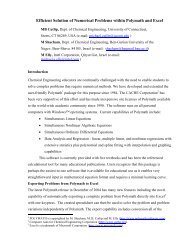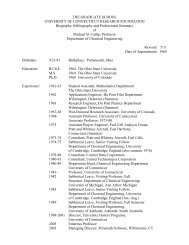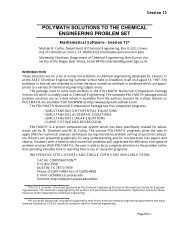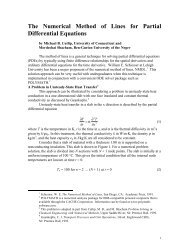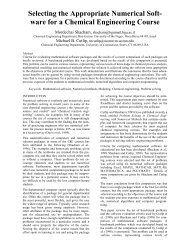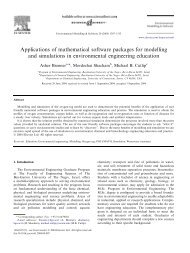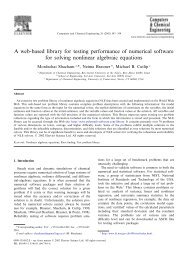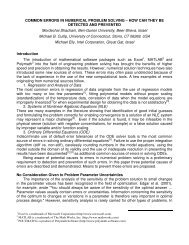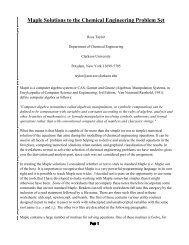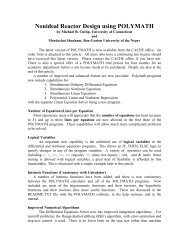Download - Polymath Software
Download - Polymath Software
Download - Polymath Software
Create successful ePaper yourself
Turn your PDF publications into a flip-book with our unique Google optimized e-Paper software.
THE USE OF MATHEMATICAL SOFTWARE<br />
PACKAGES IN CHEMICAL ENGINEERING<br />
A COLLECTION OF REPRESENTATIVE PROBLEMS IN CHEMICAL<br />
ENGINEERING FOR SOLUTION BY NUMERICAL METHODS<br />
INTRODUCTION<br />
Mathematical <strong>Software</strong> - Session 12*<br />
Michael B. Cutlip, Department of Chemical Engineering, Box U-222, University<br />
of Connecticut, Storrs, CT 06269-3222 (mcutlip@uconnvm.uconn.edu)<br />
John J. Hwalek, Department of Chemical Engineering, University of Maine,<br />
Orono, ME 04469 (hwalek@maine.maine.edu)<br />
H. Eric Nuttall, Department of Chemical and Nuclear Engineering, University<br />
of New Mexico, Albuquerque, NM 87134-1341 (nuttall@unm.edu)<br />
Mordechai Shacham, Department of Chemical Engineering, Ben-Gurion University<br />
of the Negev, Beer Sheva, Israel 84105 (shacham@bgumail.bgu.ac.il)<br />
Additional Contributors:<br />
Joseph Brule, John Widmann, Tae Han, and Bruce Finlayson, Department of<br />
Chemical Engineering, University of Washington, Seattle, WA 98195-1750<br />
(finlayson@cheme.washington.edu)<br />
Edward M. Rosen, EMR Technology Group, 13022 Musket Ct., St. Louis, MO<br />
63146 (EMRose@compuserve.com)<br />
Ross Taylor, Department of Chemical Engineering, Clarkson University, Potsdam,<br />
NY 13699-5705 (taylor@sun.soe.clarkson.edu)<br />
This collection of problems was developed for Session 12 at the ASEE Chemical Engineering<br />
Summer School held in Snowbird, Utah on August 13, 1997. These problems<br />
are intended to utilize the basic numerical methods in problems which are appropriate<br />
to a variety of chemical engineering subject areas. The problems are titled according<br />
to the chemical engineering principles which are used, the problems are arranged<br />
according to the numerical methods which are applied as summarized in Table 1.<br />
The problem has been solved by each of the mathematical packages: Excel,<br />
Maple, Mathcad*, MATLAB, Mathematica*, and <strong>Polymath</strong>*. The CACHE Corporation<br />
has made available this problem set as well as the individual package writeups<br />
* This material was originally distributed at the Chemical Engineering Summer School at Snowbird,<br />
Utah on August 13, 1997 in Session 12 entitled “The Use of Mathematical <strong>Software</strong> in Chemical<br />
Engineering.” The Ch. E. Summer School was sponsored by the Chemical Engineering Division of the<br />
American Society for Engineering Education. This material is copyrighted by the authors, and permission<br />
must be obtained for duplication unless for educational use within departments of chemical engineering.<br />
Page 1
Page 2 MATHEMATICAL SOFTWARE PACKAGES IN CHEMICAL ENGINEERING<br />
and problem solutions at http://www.che.utexas.edu/cache/. The materials are also available via anonymous<br />
FTP from ftp.engr.uconn.edu in directory /pub/ASEE. The problem set and details of the various<br />
solutions are given in separate documents as Adobe PDF files. Additionally, the problem sets are<br />
available for the various mathematical package as working files which can be downloaded for execution<br />
with the mathematical software. This method of presentation should indicate the convenience<br />
and strengths/weaknesses of each of the mathematical software packages and provides working solutions.<br />
The selection of problems has been coordinated by M. B. Cutlip who served as the session chairman.<br />
The particular co-author who has considerable experience with a particular mathematical package<br />
is responsible for the solution with that package*.<br />
Excel** - Edward M. Rosen, EMR Technology Group<br />
Maple** - Ross Taylor, Clarkson University<br />
Mathematica** - H. Eric Nuttall, University of New Mexico<br />
Mathcad** - John J. Hwalek, University of Maine<br />
MATLAB** - Joseph Brule, John Widmann, Tae Han, and Bruce Finlayson, Department of<br />
Chemical Engineering, University of Washington<br />
POLYMATH** - Michael B. Cutlip, University of Connecticut and Mordechai Shacham, Ben-<br />
Gurion University of the Negev<br />
This selection of problems should help chemical engineering faculty evaluate which mathematical<br />
problem solving package they wish to use in their courses and should provide some typical problems<br />
in various courses which can be utilized.<br />
* The CACHE Corporation is non-profit educational corporation supported by most chemical engineering departments<br />
and many chemical corporation. CACHE stands for computer aides for chemical engineering. CACHE can be contacted at P.<br />
O. Box 7939, Austin, TX 78713-7939, Phone: (512)471-4933 Fax: (512)295-4498, E-mail: cache@uts.cc.utexas.edu, Internet:<br />
http://www.che.utexas.edu/cache/<br />
** Excel is a trademark of Microsoft Corporation (http://www.microsoft.com), Maple is a trademark of Waterloo Maple,<br />
Inc. (http://maplesoft.com), Mathematica is a trademark of Wolfram Research, Inc. (http://www.wolfram.com), Mathcad is a<br />
trademark of Mathsoft, Inc. (http://www.mathsoft.com), MATLAB is a trademark of The Math Works, Inc. (http://www.mathworks.com),<br />
and POLYMATH is copyrighted by M. B. Cutlip and M. Shacham (http://www.polymath-software.com).
Problem Selection<br />
Page 3<br />
Table 1 Selection of Problems Solutions Illustrating Mathematical <strong>Software</strong><br />
COURSE PROBLEM TITLE<br />
Introduction to<br />
Ch. E.<br />
Introduction to<br />
Ch. E.<br />
Mathematical<br />
Methods<br />
Molar Volume and Compressibility Factor<br />
from Van Der Waals Equation<br />
Steady State Material Balances on a Separation<br />
Train*<br />
Vapor Pressure Data Representation by<br />
Polynomials and Equations<br />
Thermodynamics Reaction Equilibrium for Multiple Gas<br />
Phase Reactions*<br />
* Problem originally suggested by H. S. Fogler of the University of Michigan<br />
** Problem preparation assistance by N. Brauner of Tel-Aviv University<br />
MATHEMATICAL<br />
MODEL PROBLEM<br />
Single Nonlinear<br />
Equation<br />
Simultaneous Linear<br />
Equations<br />
Polynomial Fitting,<br />
Linear and<br />
Nonlinear Regression<br />
Simultaneous<br />
Nonlinear Equations<br />
Fluid Dynamics Terminal Velocity of Falling Particles Single Nonlinear<br />
Equation<br />
Heat Transfer Unsteady State Heat Exchange in a<br />
Series of Agitated Tanks*<br />
Mass Transfer Diffusion with Chemical Reaction in a<br />
One Dimensional Slab<br />
Separation<br />
Processes<br />
Reaction<br />
Engineering<br />
Process Dynamics<br />
and Control<br />
Simultaneous<br />
ODE’s with known<br />
initial conditions.<br />
Simultaneous<br />
ODE’s with split<br />
boundary conditions.<br />
Binary Batch Distillation** Simultaneous Differential<br />
and Nonlinear<br />
Algebraic<br />
Equations<br />
Reversible, Exothermic, Gas Phase Reaction<br />
in a Catalytic Reactor*<br />
Dynamics of a Heated Tank with PI Temperature<br />
Control**<br />
Simultaneous<br />
ODE’s and Algebraic<br />
Equations<br />
Simultaneous Stiff<br />
ODE’s<br />
These problem are taken in part from a new book entitled “Problem Solving in Chemical Engineering with Numerical<br />
Methods” by Michael B. Cutlip and Mordechai Shacham to be published by Prentice-Hall in 1999.<br />
1<br />
2<br />
3<br />
4<br />
5<br />
6<br />
7<br />
8<br />
9<br />
10
Page 4 MATHEMATICAL SOFTWARE PACKAGES IN CHEMICAL ENGINEERING<br />
1. MOLAR VOLUME AND COMPRESSIBILITY FACTOR FROM VAN<br />
DER<br />
WAALS<br />
EQUATION<br />
1.1 Numerical Methods<br />
Solution of a single nonlinear algebraic equation.<br />
1.2 Concepts Utilized<br />
Use of the van der Waals equation of state to calculate molar volume and compressibility factor for a<br />
gas.<br />
1.3 Course Useage<br />
Introduction to Chemical Engineering, Thermodynamics.<br />
1.4 Problem Statement<br />
The ideal gas law can represent the pressure-volume-temperature (PVT) relationship of gases only at<br />
low (near atmospheric) pressures. For higher pressures more complex equations of state should be<br />
used. The calculation of the molar volume and the compressibility factor using complex equations of<br />
state typically requires a numerical solution when the pressure and temperature are specified.<br />
The van der Waals equation of state is given by<br />
where<br />
and<br />
The variables are defined by<br />
P = pressure in atm<br />
V = molar volume in liters/g-mol<br />
a<br />
P<br />
V 2<br />
⎛ +<br />
⎝<br />
------ ⎞( V – b)<br />
= RT<br />
⎠<br />
a 27<br />
-----<br />
64<br />
R2 2<br />
⎛ Tc⎞ = ⎜------------- ⎟<br />
⎝ Pc ⎠<br />
b RTc =<br />
----------<br />
8Pc T = temperature in K<br />
R = gas constant ( R = 0.08206 atm.<br />
liter/g-mol.<br />
K)<br />
Tc<br />
= critical temperature (405.5 K for ammonia)<br />
Pc<br />
= critical pressure (111.3 atm for ammonia)<br />
(1)<br />
(2)<br />
(3)
Problem 1. MOLAR VOLUME AND COMPRESSIBILITY FACTOR FROM VAN DER WAALS EQUATION Page 5<br />
Reduced pressure is defined as<br />
and the compressibility factor is given by<br />
Pr= P<br />
-----<br />
Pc Z PV<br />
= --------<br />
RT<br />
(a) Calculate the molar volume and compressibility factor for gaseous ammonia at a pressure<br />
P = 56 atm and a temperature T = 450 K using the van der Waals equation of state.<br />
(b) Repeat the calculations for the following reduced pressures: P r = 1, 2, 4, 10, and 20.<br />
(c) How does the compressibility factor vary as a function of P r .?<br />
(4)<br />
(5)
Page 6<br />
MATHEMATICAL SOFTWARE PACKAGES IN CHEMICAL ENGINEERING<br />
2. STEADY<br />
STATE<br />
MATERIAL<br />
BALANCES<br />
ON A SEPARATION<br />
TRAIN<br />
2.1 Numerical Methods<br />
Solution of simultaneous linear equations.<br />
2.2 Concepts Utilized<br />
Material balances on a steady state process with no recycle.<br />
2.3 Course Useage<br />
Introduction to Chemical Engineering.<br />
2.4 Problem Statement<br />
Xylene, styrene, toluene and benzene are to be separated with the array of distillation columns that is<br />
shown below where F, D, B, D1, B1, D2 and B2 are the molar flow rates in mol/min.<br />
15% Xylene<br />
25% Styrene<br />
40% Toluene<br />
20% Benzene<br />
F=70 mol/min<br />
Figure 1 Separation Train<br />
D<br />
#1<br />
B<br />
D 1<br />
#2<br />
B 1<br />
D 2<br />
#3<br />
B 2<br />
{<br />
{<br />
{<br />
{<br />
7% Xylene<br />
4% Styrene<br />
54% Toluene<br />
35% Benzene<br />
18% Xylene<br />
24% Styrene<br />
42% Toluene<br />
16% Benzene<br />
15% Xylene<br />
10% Styrene<br />
54% Toluene<br />
21% Benzene<br />
24% Xylene<br />
65% Styrene<br />
10% Toluene<br />
1% Benzene
Problem 2. STEADY STATE MATERIAL BALANCES ON A SEPARATION TRAIN Page 7<br />
Material balances on individual components on the overall separation train yield the equation set<br />
Xylene: 0.07D<br />
1<br />
+ 0.18B<br />
1<br />
+ 0.15D<br />
2<br />
+ 0.24B<br />
2<br />
=<br />
Styrene: 0.04D<br />
1<br />
+ 0.24B<br />
1<br />
+ 0.10D<br />
2<br />
+ 0.65B<br />
2<br />
=<br />
Toluene: 0.54D<br />
1<br />
+ 0.42B<br />
1<br />
+ 0.54D<br />
2<br />
+ 0.10B<br />
2<br />
=<br />
Benzene: 0.35D<br />
1<br />
+ 0.16B<br />
1<br />
+ 0.21D<br />
2<br />
+ 0.01B<br />
2<br />
=<br />
0.15 × 70<br />
0.25 × 70<br />
0.40 × 70<br />
Overall balances and individual component balances on column #2 can be used to determine the<br />
molar flow rate and mole fractions from the equation of stream D from<br />
Molar Flow Rates: D = D 1 + B 1<br />
Xylene: X Dx D = 0.07D 1 + 0.18B 1<br />
Styrene: X Ds D = 0.04D 1 + 0.24B 1<br />
Toluene: X Dt D = 0.54D 1 + 0.42B 1<br />
Benzene: X Db D = 0.35D 1 + 0.16B 1<br />
0.20 × 70<br />
where XDx<br />
= mole fraction of Xylene, XDs<br />
= mole fraction of Styrene, XDt<br />
= mole fraction of Toluene,<br />
and XDb<br />
= mole fraction of Benzene.<br />
Similarly, overall balances and individual component balances on column #3 can be used to<br />
determine the molar flow rate and mole fractions of stream B from the equation set<br />
Molar Flow Rates: B = D 2 + B 2<br />
Xylene: X Bx B = 0.15D 2 + 0.24B 2<br />
Styrene: X Bs B = 0.10D 2 + 0.65B 2<br />
Toluene: X Bt B = 0.54D 2 + 0.10B 2<br />
Benzene: X Bb B = 0.21D 2 + 0.01B 2<br />
(a) Calculate the molar flow rates of streams D 1 , D 2 , B 1 and B 2 .<br />
(b) Determine the molar flow rates and compositions of streams B and D.<br />
(6)<br />
(7)<br />
(8)
Page 8 MATHEMATICAL SOFTWARE PACKAGES IN CHEMICAL ENGINEERING<br />
3. VAPOR PRESSURE DATA REPRESENTATION BY POLYNOMIALS AND EQUATIONS<br />
3.1 Numerical Methods<br />
Regression of polynomials of various degrees. Linear regression of mathematical models with variable<br />
transformations. Nonlinear regression.<br />
3.2 Concepts Utilized<br />
Use of polynomials, a modified Clausius-Clapeyron equation, and the Antoine equation to model vapor<br />
pressure versus temperature data<br />
3.3 Course Useage<br />
Mathematical Methods, Thermodynamics.<br />
3.4 Problem Statement<br />
Table (2) presents data of vapor pressure versus temperature for benzene. Some design calculations<br />
Table 2 Vapor Pressure of Benzene (Perry 3 )<br />
Temperature, T<br />
( o C)<br />
Pressure, P<br />
(mm Hg)<br />
-36.7 1<br />
-19.6 5<br />
-11.5 10<br />
-2.6 20<br />
+7.6 40<br />
15.4 60<br />
26.1 100<br />
42.2 200<br />
60.6 400<br />
80.1 760<br />
require these data to be accurately correlated by various algebraic expressions which provide P in<br />
mmHg as a function of T in °C.<br />
A simple polynomial is often used as an empirical modeling equation. This can be written in general<br />
form for this problem as<br />
P a0a1T a2T2 a3T 3 ...+anT n<br />
=<br />
+ + + +<br />
where a 0 ... a n are the parameters (coefficients) to be determined by regression and n is the degree of<br />
the polynomial. Typically the degree of the polynomial is selected which gives the best data represen-<br />
(9)
Problem 3. VAPOR PRESSURE DATA REPRESENTATION BY POLYNOMIALS AND EQUATIONS Page 9<br />
tation when using a least-squares objective function.<br />
The Clausius-Clapeyron equation which is useful for the correlation of vapor pressure data is<br />
given by<br />
log( P)<br />
= A<br />
B<br />
– --------------------------<br />
T + 273.15<br />
where P is the vapor pressure in mmHg and T is the temperature in °C. Note that the denominator is<br />
just the absolute temperature in K. Both A and B are the parameters of the equation which are typically<br />
determined by regression.<br />
The Antoine equation which is widely used for the representation of vapor pressure data is given<br />
by<br />
log( P)<br />
= A<br />
B<br />
– --------------<br />
T + C<br />
where typically P is the vapor pressure in mmHg and T is the temperature in °C. Note that this equation<br />
has parameters A, B, and C which must be determined by nonlinear regression as it is not possible<br />
to linearize this equation. The Antoine equation is equivalent to the Clausius-Clapeyron equation<br />
when C = 273.15.<br />
(a) Regress the data with polynomials having the form of Equation (9). Determine the degree of<br />
polynomial which best represents the data.<br />
(b) Regress the data using linear regression on Equation (10), the Clausius-Clapeyron equation.<br />
(c) Regress the data using nonlinear regression on Equation (11), the Antoine equation.<br />
(10)<br />
(11)
Page 10 MATHEMATICAL SOFTWARE PACKAGES IN CHEMICAL ENGINEERING<br />
4. REACTION EQUILIBRIUM FOR MULTIPLE GAS PHASE REACTIONS<br />
4.1 Numerical Methods<br />
Solution of systems of nonlinear algebraic equations.<br />
4.2 Concepts Utilized<br />
Complex chemical equilibrium calculations involving multiple reactions.<br />
4.3 Course Useage<br />
Thermodynamics or Reaction Engineering.<br />
4.4 Problem Statement<br />
The following reactions are taking place in a constant volume, gas-phase batch reactor.<br />
A+ B↔C+<br />
D<br />
B+ C↔X + Y<br />
A+ X ↔ Z<br />
A system of algebraic equations describes the equilibrium of the above reactions. The nonlinear<br />
equilibrium relationships utilize the thermodynamic equilibrium expressions, and the linear relationships<br />
have been obtained from the stoichiometry of the reactions.<br />
K C1 =<br />
CCC D<br />
----------------<br />
C ACB K C2 =<br />
CX CY ----------------<br />
CBC C<br />
K C3 =<br />
CZ ----------------<br />
C AC X<br />
C A = C A0 – CD – CZ CB = CB0 – CD – CY CC = CD – CY CY = CX + CZ In this equation set C A , CB , CC , CD , CX , CY and CZ are concentrations of the various species at<br />
equilibrium resulting from initial concentrations of only CA0 and CB0 . The equilibrium constants KC1 ,<br />
KC2 and KC3 have known values.<br />
Solve this system of equations when CA0 = CB0 = 1.5, K C1 = 1.06 , K C2 = 2.63 and K C3 = 5<br />
starting from four sets of initial estimates.<br />
(a) CD = CX = CZ = 0<br />
(b) CD = CX = CZ = 1<br />
(c) CD = CX = CZ =<br />
10<br />
(12)
Problem 5. TERMINAL VELOCITY OF FALLING PARTICLES Page 11<br />
5. TERMINAL VELOCITY OF FALLING PARTICLES<br />
5.1 Numerical Methods<br />
Solution of a single nonlinear algebraic equation..<br />
5.2 Concepts Utilized<br />
Calculation of terminal velocity of solid particles falling in fluids under the force of gravity.<br />
5.3 Course Useage<br />
Fluid dynamics.<br />
5.4 Problem Statement<br />
A simple force balance on a spherical particle reaching terminal velocity in a fluid is given by<br />
where is the terminal velocity in m/s, g is the acceleration of gravity given by g = 9.80665 m/s 2 ,<br />
is the particles density in kg/m3 , ρ is the fluid density in kg/m3 , is the diameter of the spherical<br />
particle in m and CD is a dimensionless drag coefficient.<br />
The drag coefficient on a spherical particle at terminal velocity varies with the Reynolds number<br />
(Re) as follows (pp. 5-63, 5-64 in Perry3 vt ρ p<br />
D p<br />
).<br />
C D<br />
where Re = Dpvt ρ⁄ μ and μ is the viscosity in Pa⋅s or kg/m⋅s.<br />
C D<br />
v t<br />
=<br />
4 g( ρ p – ρ)Dp<br />
------------------------------------<br />
3CDρ 24<br />
= ------ for Re < 0.1<br />
Re<br />
24<br />
------ 1 0.14Re<br />
Re<br />
0.7<br />
= ( + ) for 0.1 ≤ Re ≤ 1000<br />
C D<br />
= 0.44 for 1000 < Re ≤ 350000<br />
4<br />
CD = 0.19 – 8×10<br />
⁄ Re for 350000 < Re<br />
(a) Calculate the terminal velocity for particles of coal with ρp = 1800 kg/m3 and =<br />
0.208×10-3 m falling in water at T = 298.15 K where ρ = 994.6 kg/m3 and μ = 8.931×10−4 D p<br />
kg/<br />
m⋅s.<br />
(b) Estimate the terminal velocity of the coal particles in water within a centrifugal separator<br />
where the acceleration is 30.0 g.<br />
(13)<br />
(14)<br />
(15)<br />
(16)<br />
(17)
Page 12 MATHEMATICAL SOFTWARE PACKAGES IN CHEMICAL ENGINEERING<br />
6. HEAT EXCHANGE IN A SERIES OF TANKS<br />
6.1 Numerical Methods<br />
Solution of simultaneous first order ordinary differential equations.<br />
6.2 Concepts Utilized<br />
Unsteady state energy balances, dynamic response of well mixed heated tanks in series.<br />
6.3 Course Useage<br />
Heat Transfer.<br />
6.4 Problem Statement<br />
Three tanks in series are used to preheat a multicomponent oil solution before it is fed to a distillation<br />
column for separation as shown in Figure (2). Each tank is initially filled with 1000 kg of oil at 20°C.<br />
Saturated steam at a temperature of 250°C condenses within coils immersed in each tank. The oil is<br />
fed into the first tank at the rate of 100 kg/min and overflows into the second and the third tanks at<br />
the same flow rate. The temperature of the oil fed to the first tank is 20°C. The tanks are well mixed so<br />
that the temperature inside the tanks is uniform, and the outlet stream temperature is the temperature<br />
within the tank. The heat capacity, Cp , of the oil is 2.0 KJ/kg. For a particular tank, the rate at<br />
which heat is transferred to the oil from the steam coil is given by the expression<br />
Q = UA( Tsteam – T)<br />
where UA = 10 kJ/min·°C is the product of the heat transfer coefficient and the area of the coil for<br />
each tank, T = temperature of the oil in the tank in °C , and Q = rate of heat transferred in kJ/min.<br />
T 0 =20 o C<br />
W 1 =100 kg/min<br />
T 1<br />
Steam<br />
Figure 2 Series of Tanks for Oil Heating<br />
T 2<br />
Steam<br />
Energy balances can be made on each of the individual tanks. In these balances, the mass flow<br />
rate to each tank will remain at the same fixed value. Thus W = W 1 = W 2 = W 3 . The mass in each tank<br />
will be assumed constant as the tank volume and oil density are assumed to be constant. Thus M = M 1<br />
= M 2 = M 3 . For the first tank, the energy balance can be expressed by<br />
Accumulation = Input - Output<br />
T 3<br />
Steam<br />
T 1 T 2 T 3<br />
dT1 MCp---------- =<br />
WC<br />
dt pT 0 + UA( Tsteam – T1) – WCpT 1<br />
(18)<br />
(19)
Problem 6. HEAT EXCHANGE IN A SERIES OF TANKS Page 13<br />
Note that the unsteady state mass balance is not needed for tank 1 or any other tanks since the mass<br />
in each tank does not change with time. The above differential equation can be rearranged and explicitly<br />
solved for the derivative which is the usual format for numerical solution.<br />
dT1 ---------- = [ WC<br />
dt<br />
p( T0 – T1) + UA( Tsteam – T1) ] ⁄ ( MCp) Similarly for the second tank<br />
For the third tank<br />
dT2 ---------- = [ WC<br />
dt<br />
p( T1 – T2) + UA( Tsteam – T2) ] ⁄ ( MCp) dT3 ---------- = [ WC<br />
dt<br />
p( T2 – T3) + UA( Tsteam – T3) ] ⁄ ( MCp) Determine the steady state temperatures in all three tanks. What time interval will be required<br />
for T 3 to reach 99% of this steady state value during startup?<br />
(20)<br />
(21)<br />
(22)
Page 14 MATHEMATICAL SOFTWARE PACKAGES IN CHEMICAL ENGINEERING<br />
7. DIFFUSION WITH CHEMICAL REACTION IN A ONE DIMENSIONAL SLAB<br />
7.1 Numerical Methods<br />
Solution of second order ordinary differential equations with two point boundary conditions.<br />
7.2 Concepts Utilized<br />
Methods for solving second order ordinary differential equations with two point boundary values typically<br />
used in transport phenomena and reaction kinetics.<br />
7.3 Course Useage<br />
Transport Phenomena and Reaction Engineering.<br />
7.4 Problem Statement<br />
The diffusion and simultaneous first order irreversible chemical reaction in a single phase containing<br />
only reactant A and product B results in a second order ordinary differential equation given by<br />
z 2<br />
2<br />
d C A k<br />
= ----------- C<br />
d<br />
D A<br />
AB<br />
where C A is the concentration of reactant A (kg mol/m 3 ), z is the distance variable (m), k is the homogeneous<br />
reaction rate constant (s -1 ) and D AB is the binary diffusion coefficient (m 2 /s). A typical geometry<br />
for Equation (23) is that of a one dimension layer which has its surface exposed to a known<br />
concentration and allows no diffusion across its bottom surface. Thus the initial and boundary conditions<br />
are<br />
C A<br />
=<br />
C A0 for z = 0<br />
dC A<br />
= 0 for z = L<br />
(25)<br />
dz<br />
where CA0 is the constant concentration at the surface (z = 0) and there is no transport across the bottom<br />
surface (z = L) so the derivative is zero.<br />
This differential equation has an analytical solution given by<br />
cosh[<br />
L( k ⁄ DAB) ( 1 – z⁄ L)<br />
]<br />
C A =<br />
C A0----------------------------------------------------------------------------<br />
cosh(<br />
L k⁄ DAB) (23)<br />
(24)<br />
(26)
Problem 7. DIFFUSION WITH CHEMICAL REACTION IN A ONE DIMENSIONAL SLAB Page 15<br />
(a) Numerically solve Equation (23) with the boundary conditions of (24) and (25) for the case<br />
where C A0 = 0.2 kg mol/m 3 , k = 10 -3 s -1 , D AB = 1.2 10 -9 m 2 /s, and L = 10 -3 m. This solution<br />
should utilized an ODE solver with a shooting technique and employ Newton’s method or<br />
some other technique for converging on the boundary condition given by Equation (25).<br />
(b) Compare the concentration profiles over the thickness as predicted by the numerical solution<br />
of (a) with the analytical solution of Equation (26).
Page 16 MATHEMATICAL SOFTWARE PACKAGES IN CHEMICAL ENGINEERING<br />
8. BINARY BATCH DISTILLATION<br />
8.1 Numerical Methods<br />
Solution of a system of equations comprised of ordinary differential equations and nonlinear<br />
algebraic equations.<br />
8.2 Concepts Utilized<br />
Batch distillation of an ideal binary mixture.<br />
8.3 Course Useage<br />
Separation Processes.<br />
8.4 Problem Statement<br />
For a binary batch distillation process involving two components designated 1 and 2, the moles of liquid<br />
remaining, L, as a function of the mole fraction of the component 2, x2 , can be expressed by the following<br />
equation<br />
dL L<br />
--------- = -------------------------<br />
(27)<br />
dx2 x2( k2 – 1)<br />
where k2 is the vapor liquid equilibrium ratio for component 2. If the system may be considered ideal,<br />
the vapor liquid equilibrium ratio can be calculated from ki = Pi ⁄ P where Pi is the vapor pressure of<br />
component i and P is the total pressure.<br />
A common vapor pressure model is the Antoine equation which utilizes three parameters A, B,<br />
and C for component i as given below where T is the temperature in °C.<br />
P i<br />
⎛ B<br />
A – -------------- ⎞<br />
⎝ T + C⎠<br />
= 10<br />
The temperature in the batch still follow the bubble point curve. The bubble point temperature is<br />
defined by the implicit algebraic equation which can be written using the vapor liquid equilibrium<br />
ratios as<br />
k1x 1 + k2x 2 =<br />
1<br />
Consider a binary mixture of benzene (component 1) and toluene (component 2) which is to be<br />
considered as ideal. The Antoine equation constants for benzene are A 1 = 6.90565, B 1 = 1211.033 and<br />
C 1 = 220.79. For toluene A 2 = 6.95464, B 2 = 1344.8 and C 2 = 219.482 (Dean 1 ). P is the pressure in mm<br />
(28)<br />
(29)
Problem 8. BINARY BATCH DISTILLATION Page 17<br />
Hg and T the temperature in °C.<br />
The batch distillation of benzene (component 1) and toluene (component 2) mixture is being carried<br />
out at a pressure of 1.2 atm. Initially, there are 100 moles of liquid in the still, comprised of<br />
60% benzene and 40% toluene (mole fraction basis). Calculate the amount of liquid remaining in<br />
the still when concentration of toluene reaches 80%.
Page 18 MATHEMATICAL SOFTWARE PACKAGES IN CHEMICAL ENGINEERING<br />
9. REVERSIBLE, EXOTHERMIC, GAS PHASE REACTION IN A CATALYTIC REACTOR<br />
9.1 Numerical Methods<br />
Simultaneous ordinary differential equations with known initial conditions.<br />
9.2 Concepts Utilized<br />
Design of a gas phase catalytic reactor with pressure drop for a first order reversible gas phase reaction.<br />
9.3 Course Useage<br />
Reaction Engineering<br />
9.4 Problem Statement<br />
The elementary gas phase reaction 2 A C is carried out in a packed bed reactor. There is a heat<br />
exchanger surrounding the reactor, and there is a pressure drop along the length of the reactor.<br />
F A0<br />
T 0<br />
The various parameters values for this reactor design problem are summarized in Table (3).<br />
Table 3 Parameter Values for Problem 9.<br />
C PA = 40.0 J/g-mol . K R = 8.314 J/g-mol . K<br />
C PC = 80.0 J/g-mol . K F A0 = 5.0 g-mol/min<br />
= - 40,000 J/g-mol Ua = 0.8 J/kg . min . K<br />
EA = 41,800 J/g-mol . K Ta = 500 K<br />
k = 0.5 dm 6 /kg⋅min⋅mol @ 450 K = 0.015 kg -1<br />
ΔH<br />
R<br />
α<br />
K C = 25,000 dm 3 /g-mol @ 450 K P 0 = 10 atm<br />
C A0 = 0.271 g-mol/dm 3 y A0 = 1.0 (Pure A feed)<br />
T 0 = 450 K<br />
T a<br />
q<br />
T a<br />
Figure 3 Packed Bed Catalytic Reactor<br />
q<br />
X<br />
T
Problem 9. REVERSIBLE, EXOTHERMIC, GAS PHASE REACTION IN A CATALYTIC REACTOR Page 19<br />
(a) Plot the conversion (X), reduced pressure (y) and temperature (T ×10 -3 ) along the reactor<br />
from W = 0 kg up to W = 20 kg.<br />
(b) Around 16 kg of catalyst you will observe a “knee” in the conversion profile. Explain why this<br />
knee occurs and what parameters affect the knee.<br />
(c) Plot the concentration profiles for reactant A and product C from W = 0 kg up to W = 20 kg.<br />
Addition Information<br />
The notation used here and the following equations and relationships for this particular problem are<br />
adapted from the textbook by Fogler. 2 The problem is to be worked assuming plug flow with no radial<br />
gradients of concentrations and temperature at any location within the catalyst bed. The reactor<br />
design will use the conversion of A designated by X and the temperature T which are both functions of<br />
location within the catalyst bed specified by the catalyst weight W.<br />
The general reactor design expression for a catalytic reaction in terms of conversion is a mole<br />
balance on reactant A given by<br />
dX<br />
F A0---------<br />
= – r'<br />
dW A<br />
The simple catalytic reaction rate expression for this reversible reaction is<br />
– r' A k C2 A<br />
where the rate constant is based on reactant A and follows the Arrhenius expression<br />
CC = – --------<br />
K C<br />
The stoichiometry for 2 A C and the stoichiometric table for a gas allow the concentrations to<br />
be expressed as a function of conversion and temperature while allowing for volumetric changes due<br />
to decrease in moles during the reaction. Therefore<br />
and<br />
E A<br />
k = k( @T=450°K ) exp-------<br />
R<br />
1 1<br />
-------- – ---<br />
450 T<br />
and the equilibrium constant variation with temperature can be determined from van’t Hoff’s equation<br />
with C<br />
(33)<br />
˜ Δ P = 0<br />
K C =<br />
ΔH<br />
R<br />
K C( @T=450°K ) exp------------<br />
R<br />
1 1<br />
-------- – ---<br />
450 T<br />
C A<br />
C ⎛ 1 – X<br />
A0 ---------------- ⎞ P<br />
------<br />
⎝1+ εX⎠P0<br />
T0 1 – X T<br />
------ C ⎛<br />
T A0 --------------------- ⎞ 0<br />
= =<br />
y------ ⎝1– 0.5 X⎠<br />
T<br />
y<br />
=<br />
P<br />
------<br />
P0 0.5C A0 X T<br />
C ⎛<br />
C ----------------------- ⎞ 0<br />
=<br />
y------ ⎝ 1 – 0.5 X ⎠ T<br />
(30)<br />
(31)<br />
(32)<br />
(34)<br />
(35)
or<br />
Page 20 MATHEMATICAL SOFTWARE PACKAGES IN CHEMICAL ENGINEERING<br />
The pressure drop can be expressed as a differential equation (see Fogler 2 for details)<br />
d P ⎛------ ⎞<br />
⎝P⎠ 0 – α( 1 + εX )<br />
-----------------------------------------dW 2<br />
P0 ------<br />
P<br />
T<br />
=<br />
------<br />
T0 dy<br />
-------dW<br />
The general energy balance may be written at<br />
– α( 1 – 0.5 X )<br />
---------------------------------<br />
2 y<br />
T<br />
=<br />
------<br />
T0 dT<br />
--------dW<br />
Ua Ta T – ( ) r' A H + ( Δ R)<br />
F A0 θiC Pi X C˜ = --------------------------------------------------------------<br />
( + Δ P)<br />
which for only reactant A in the reactor feed simplifies to<br />
∑<br />
dT<br />
--------dW<br />
Ua Ta T – ( ) r' A H + ( Δ R)<br />
=<br />
--------------------------------------------------------------<br />
F A0( CPA) (36)<br />
(37)<br />
(38)<br />
(39)
Problem 10. DYNAMICS OF A HEATED TANK WITH PI TEMPERATURE CONTROL Page 21<br />
10. DYNAMICS OF A HEATED TANK WITH PI TEMPERATURE CONTROL<br />
10.1 Numerical Methods<br />
Solution of ordinary differential equations, generation of step functions, simulation of a proportional<br />
integral controller.<br />
10.2 Concepts Utilized<br />
Closed loop dynamics of a process including first order lag and dead time. Padé approximation of time<br />
delay.<br />
10.3 Course Useage<br />
Process Dynamics and Control<br />
10.4 Problem Statement<br />
A continuous process system consisting of a well-stirred tank, heater and PI temperature controller is<br />
depicted in Figure (4). The feed stream of liquid with density of ρ in kg/m 3 and heat capacity of C in<br />
kJ / kg⋅°C flows into the heated tank at a constant rate of W in kg/min and temperature Ti in °C. The<br />
volume of the tank is V in m3 . It is desired to heat this stream to a higher set point temperature Tr in<br />
°C. The outlet temperature is measured by a thermocouple as Tm in °C, and the required heater input<br />
q in kJ/min is adjusted by a PI temperature controller. The control objective is to maintain T0 = Tr in<br />
the presence of a change in inlet temperature Ti which differs from the steady state design temperature<br />
of Tis .<br />
Feed<br />
W, T i , ρ, C p<br />
Heater TC<br />
q<br />
V, T<br />
PI<br />
controller<br />
Thermocouple<br />
Measured<br />
Tm Set point<br />
T r<br />
W, T 0 , ρ, C p<br />
Figure 4 Well Mixed Tank with Heater and Temperature Controller
Page 22 MATHEMATICAL SOFTWARE PACKAGES IN CHEMICAL ENGINEERING<br />
Modeling and Control Equations<br />
An energy balance on the stirred tank yields<br />
dT<br />
------- (40)<br />
dt<br />
with initial condition T = Tr at t = 0 which corresponds to steady state operation at the set point temperature<br />
Tr ..<br />
The thermocouple for temperature sensing in the outlet stream is described by a first order system<br />
plus the dead time τd which is the time for the output flow to reach the measurement point. The<br />
dead time expression is given by<br />
WCp Ti T – ( ) q +<br />
= -------------------------------------------ρVCp<br />
The effect of dead time may be calculated for this situation by the Padé approximation which is a first<br />
order differential equation for the measured temperature.<br />
dT0 ---------- = T – T<br />
dt<br />
0<br />
τ<br />
⎛ d<br />
----- ⎞ dT<br />
– ⎛------- ⎞<br />
⎝ 2 ⎠⎝<br />
dt⎠<br />
(41)<br />
I. C. T 0 = T r at t = 0 (steady state) (42)<br />
The above equation is used to generated the temperature input to the thermocouple, T 0 .<br />
The thermocouple shielding and electronics are modeled by a first order system for the input<br />
temperature T 0 given by<br />
dTm -----------dt<br />
T0 – Tm = --------------------τm<br />
I. C. T m = T r at t = 0 (steady state) (43)<br />
where the thermocouple time constant τ m is known.<br />
The energy input to the tank, q, as manipulated by the proportional/integral (PI) controller can<br />
be described by<br />
where K c is the proportional gain of the controller, τ I is the integral time constant or reset time. The q s<br />
in the above equation is the energy input required at steady state for the design conditions as calculated<br />
by<br />
The integral in Equation (44) can be conveniently be calculated by defining a new variable as<br />
d<br />
( errsum)<br />
= Tr – T<br />
dt<br />
m<br />
Thus Equation (44) becomes<br />
T0() t = T( t– τd) 2<br />
----τd<br />
q qsKc( Tr – Tm) K c t<br />
= + + ------ ( T<br />
τ r – Tm) dt<br />
0<br />
I<br />
(44)<br />
(45)<br />
I. C. errsum = 0 at t = 0 (steady state) (46)<br />
q qsKc( Tr – Tm) (47)<br />
Let us consider some of the interesting aspects of this system as it responds to a variety of parameter<br />
K c<br />
=<br />
+ + ------ ( errsum)<br />
τI ∫<br />
qs = WCp( Tr – Tis)
Page 23 MATHEMATICAL SOFTWARE PACKAGES IN CHEMICAL ENGINEERING<br />
and operational changes.The numerical values of the system and control parameters in Table (4) will<br />
be considered as leading to baseline steady state operation.<br />
Table 4 Baseline System and Control Parameters for Problem 10<br />
ρVC p = 4000 kJ/°C WC p = 500 kJ/min⋅°C<br />
T is = 60 °C T r = 80 °C<br />
τ d = 1 min τ m = 5 min<br />
K c = 50 kJ/min⋅°C τ I = 2 min<br />
(a) Demonstrate the open loop performance (set K c = 0) of this system when the system is initially<br />
operating at design steady state at a temperature of 80°C, and inlet temperature T i is suddenly<br />
changed to 40°C at time t = 10 min. Plot the temperatures T, T 0 , and T m to steady state,<br />
and verify that Padé approximation for 1 min of dead time given in Equation (42) is working<br />
properly.<br />
(b) Demonstrate the closed loop performance of the system for the conditions of part (a) and the<br />
baseline parameters from Table (4). Plot temperatures T, T 0 , and T m to steady state.<br />
(c) Repeat part (b) with K c = 500 kJ/min⋅°C.<br />
(d) Repeat part (c) for proportional only control action by setting the term K c /τ I = 0.<br />
(e) Implement limits on q (as per Equation (47)) so that the maximum is 2.6 times the baseline<br />
steady state value and the minimum is zero. Demonstrate the system response from baseline<br />
steady state for a proportional only controller when the set point is changed from 80°C to 90°C at<br />
t = 10 min. K c = 5000 kJ/min⋅°C. Plot q and q lim versus time to steady state to demonstrate the limits.<br />
Also plot the temperatures T, T 0 , and T m to steady state to indicate controller performance
Page 24 MATHEMATICAL SOFTWARE PACKAGES IN CHEMICAL ENGINEERING<br />
REFERENCES<br />
1. Dean, A. (Ed.), Lange’s Handbook of Chemistry, New York: McGraw-Hill, 1973.<br />
2. Fogler, H. S. Elements of Chemical Reaction Engineering, 2nd ed., Englewood Cliffs, NJ: Prentice-Hall,<br />
1992.<br />
3. Perry, R.H., Green, D.W., and Malorey, J.D., Eds. Perry’s Chemical Engineers Handbook. New York:<br />
McGraw-Hill, 1984.<br />
4. Shacham, M., Brauner; N., and Pozin, M. Computers Chem Engng., 20, Suppl. pp. S1329-S1334 (1996).



